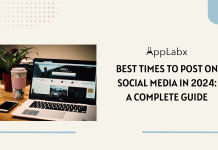Key Takeaways
- Strategic Keyword Placement: Position primary keywords at the beginning of your app title to maximize visibility in search results and enhance relevance to users’ search queries.
- Balancing Keywords with Brand Identity: Integrate brand elements with relevant keywords to create titles that resonate with your target audience while maintaining clarity and coherence with your app’s identity.
- Ongoing Optimization and Testing: Continuously monitor performance metrics, conduct A/B tests, and iterate your app titles based on data and user feedback to ensure sustained visibility and competitiveness in the dynamic app marketplace.
In the bustling world of mobile applications, where millions of apps vie for users’ attention, standing out from the crowd is paramount.
With over 5.6 million apps available on the Google Play Store and the Apple App Store as of 2022, the challenge of ensuring your app gains visibility amidst this sea of competition has never been more daunting.
This is where the art and science of App Store Optimization (ASO) come into play, with mobile app titles serving as the frontline warriors in the battle for visibility.
Welcome to our comprehensive guide on how to write ASO mobile app titles for maximum visibility.
In this digital age, where smartphones have become an indispensable part of our daily lives, the success of a mobile app hinges not only on its functionality and user experience but also on its discoverability.

And at the heart of discoverability lies the strategic optimization of app titles.
But what exactly is ASO, and why are mobile app titles so crucial in the ASO landscape?
ASO refers to the process of optimizing mobile apps to rank higher in app store search results, thereby increasing visibility and driving organic downloads.
While factors such as keywords, descriptions, icons, and screenshots all play a role in ASO, the app title arguably carries the most weight in terms of signaling relevance to both users and app store algorithms.
Think of your app title as the storefront sign of your digital establishment—a succinct yet powerful descriptor that not only communicates the essence of your app but also entices potential users to explore further. It’s the first impression your app makes on users browsing through the app store, and as the saying goes, “You never get a second chance to make a first impression.”
In this guide, we’ll delve deep into the nuances of crafting ASO mobile app titles that not only maximize visibility but also resonate with your target audience. We’ll explore the underlying principles of ASO, dissect the anatomy of effective app titles, and provide actionable strategies backed by real-world examples and industry insights.
Whether you’re a seasoned app developer looking to fine-tune your ASO strategy or a newcomer navigating the intricacies of mobile app marketing, this guide is your roadmap to success in the ever-evolving landscape of app store optimization. So, grab your metaphorical pen and paper, and let’s embark on a journey to unlock the full potential of your mobile app through the power of optimized titles.
Before we venture further, we like to share who we are and our digital experiences.
About AppLabx
From developing a solid marketing plan to creating compelling content, optimizing for search engines, leveraging social media, and utilizing paid advertising, AppLabx offers a comprehensive suite of digital marketing services designed to drive growth and profitability for your business.
AppLabx is well known for helping companies and startups use ASO to drive traffic to their websites and web apps.
At AppLabx, we understand that no two businesses are alike. That’s why we take a personalized approach to every project, working closely with our clients to understand their unique needs and goals, and developing customized strategies to help them achieve success.
If you need a digital consultation, then send in an inquiry here.
How to Write ASO Mobile App Titles for Maximum Visibility
- Understanding ASO Mobile App Titles
- Research and Analysis
- Strategies for Crafting Optimized App Titles
- Implementation and Optimization Tips
1. Understanding ASO Mobile App Titles
In the intricate web of App Store Optimization (ASO), mobile app titles serve as the cornerstone of visibility and discoverability. Understanding the pivotal role of app titles is essential for developers and marketers seeking to maximize their app’s reach and impact.
Let’s delve deeper into the nuances of ASO mobile app titles and why they matter.
Definition and Role of App Titles
- Definition: Mobile app titles refer to the succinct, descriptive names assigned to applications available for download on app stores.
- Role: App titles play a multifaceted role in ASO:
- First Impression: They serve as the initial point of contact between users and your app, influencing users’ perceptions and decisions.
- Relevance Signal: App titles signal relevance to both users and app store algorithms, impacting search rankings and visibility.
- Branding Opportunity: Titles offer a platform to convey your app’s brand identity, values, and unique selling points.
Impact of Titles on App Visibility and Rankings
- Visibility: App titles directly influence your app’s visibility within app store search results and category listings.
- Keyword Relevance: Titles containing relevant keywords are more likely to appear in search results for those terms.
- Competitive Edge: Well-optimized titles can help your app stand out amidst fierce competition, increasing exposure to potential users.
- Rankings: App titles contribute to app store ranking algorithms, affecting your app’s position in search results and top charts.
- Keyword Optimization: Strategic placement of keywords in titles can improve your app’s ranking for specific search queries.
- User Engagement: Higher rankings lead to increased visibility, driving organic downloads and user engagement.
Key Considerations for Crafting Effective App Titles
- Clarity and Conciseness: App titles should be clear, concise, and easily understandable to users.
- Avoid Jargon: Steer clear of technical jargon or obscure terms that may confuse or alienate potential users.
- Focus on Core Functionality: Highlight the primary function or purpose of your app to convey its value proposition succinctly.
- Keyword Optimization: Incorporating relevant keywords into your app title is crucial for ASO success.
- Research and Analysis: Conduct thorough keyword research to identify high-traffic, relevant keywords related to your app’s niche or category.
- Placement Strategy: Strategically place primary keywords at the beginning of the title to maximize visibility and relevance.
- Brand Identity: Balance between keyword optimization and brand identity to create a title that is both optimized for search and reflective of your app’s unique identity.
- Branding Elements: Consider incorporating brand name, tagline, or unique selling points (USPs) into the title while ensuring clarity and relevance.
- Consistency: Maintain consistency across app title, icon, description, and other branding elements to reinforce brand recognition and trust.
Example: “Fitness Tracker – Workout Log & Calorie Counter”
- Clarity and Conciseness: The title clearly communicates the app’s purpose (fitness tracking) and core features (workout logging, calorie counting) in a concise manner.
- Keyword Optimization: The inclusion of relevant keywords (“fitness tracker,” “workout log,” “calorie counter”) enhances the app’s visibility for users searching for fitness-related apps.
- Brand Identity: The inclusion of the brand name (“Fitness Tracker”) establishes brand recognition while conveying the app’s primary function.

2. Research and Analysis
In the competitive landscape of app stores, conducting comprehensive research and analysis is crucial for optimizing mobile app titles effectively.
By leveraging various tools and techniques, developers and marketers can gain valuable insights into keyword trends, competitor strategies, and user preferences, empowering them to craft titles that maximize visibility and engagement.
Let’s explore the key aspects of research and analysis in ASO mobile app titles.
Market Research Techniques
- Keyword Research: Identify relevant keywords and phrases that potential users are likely to use when searching for apps similar to yours.
- Keyword Planner Tools: Utilize keyword research tools such as Google Keyword Planner, SEMrush, or App Annie to discover high-traffic keywords related to your app’s niche or category.
- Long-Tail Keywords: Explore long-tail keywords—specific, less competitive phrases that capture users’ intent more accurately and may yield higher conversion rates.
- User Intent Analysis: Understand the underlying intent behind user searches to tailor your app title and content accordingly.
- Search Queries Analysis: Analyze common search queries related to your app’s functionality or features to align your title with user expectations.
- User Feedback and Reviews: Gather insights from user feedback and app reviews to identify recurring themes, pain points, and keywords used by your target audience.
Competitive Analysis
- Identify Competitors: Identify direct and indirect competitors within your app’s niche or category.
- Top Charts: Analyze top-performing apps in relevant categories to understand their app titles, keywords, and positioning strategies.
- Feature Comparison: Compare competitors’ app titles, descriptions, and features to identify strengths, weaknesses, and areas for differentiation.
- Keyword Analysis: Examine competitors’ use of keywords in their app titles and descriptions to identify popular search terms and trends.
- Keyword Density: Analyze the frequency and prominence of keywords in competitors’ titles to gauge their relevance and effectiveness.
- Unique Selling Propositions (USPs): Identify unique selling points or features highlighted in competitors’ titles and descriptions to inform your own positioning strategy.
Tools and Resources
- ASO Tools: Leverage ASO tools and platforms to streamline your research and analysis process.
- App Store Connect (iOS): Access keyword data and performance metrics for your app directly from the App Store Connect dashboard.
- Google Play Console (Android): Utilize Google Play Console to monitor keyword rankings, user engagement, and app performance on the Google Play Store.
- Third-Party ASO Tools: Explore third-party ASO tools such as AppFollow, Sensor Tower, or Mobile Action for comprehensive keyword research, competitor analysis, and performance tracking.
- Analytics Platforms: Integrate analytics platforms such as Firebase, Flurry, or Mixpanel to track user behavior, acquisition channels, and keyword attribution.
- Keyword Attribution: Attribute app installs and user engagement metrics to specific keywords to evaluate the effectiveness of your ASO strategies.
Example: Market Research Insights
- Keyword Research: Using tools like SEMrush, identify high-traffic keywords such as “fitness tracker,” “workout log,” and “calorie counter” relevant to a fitness tracking app.
- Competitive Analysis: Analyze top-performing fitness tracking apps to uncover their app titles, keyword strategies, and unique selling points.
- Tools and Resources: Utilize App Store Connect and Google Play Console to monitor keyword rankings and user engagement metrics for your app. Additionally, leverage third-party ASO tools like Sensor Tower to conduct in-depth keyword research and competitor analysis.

3. Strategies for Crafting Optimized App Titles
Crafting optimized app titles is a delicate balancing act that requires strategic keyword placement, clarity, and brand identity.
By implementing the following strategies, developers and marketers can create titles that not only maximize visibility but also resonate with their target audience.
Incorporating Relevant Keywords Strategically
- Keyword Placement and Density:
- Position primary keywords at the beginning of the title to maximize visibility and relevance.
- Avoid keyword stuffing by maintaining a natural flow and readability in the title.
- Balancing Keywords with Brand Identity:
- Ensure that keyword optimization does not compromise the clarity or coherence of the app title.
- Integrate brand name, tagline, or unique selling points (USPs) with relevant keywords to convey both functionality and brand identity effectively.
Utilizing App Title Best Practices
- Length and Character Limits:
- Adhere to character limits imposed by app stores to ensure that the entire title is displayed accurately.
- Optimize for different platforms: While Apple App Store allows up to 30 characters, Google Play Store permits up to 50 characters for app titles.
- Clarity and Relevance to App Functionality:
- Clearly communicate the core functionality or purpose of the app in the title to provide users with a clear understanding of what the app offers.
- Avoid ambiguity or vague terms that may confuse or mislead potential users.
Testing and Iterating: A/B Testing App Titles
- A/B Testing Methodology:
- Conduct A/B tests to compare the performance of different app titles in terms of visibility, click-through rates, and conversions.
- Test variations of titles with different keyword combinations, messaging, or branding elements to identify the most effective approach.
- Iterative Optimization:
- Continuously iterate and refine app titles based on performance data and user feedback.
- Monitor key metrics such as keyword rankings, app store impressions, and user engagement to gauge the impact of title optimizations.
Example: “Weather Forecast – Accurate Weather Updates & Radar Maps”
- Keyword Placement and Density:
- The title begins with the primary keyword (“Weather Forecast”), ensuring high visibility for users searching for weather-related apps.
- Secondary keywords (“Accurate Weather Updates,” “Radar Maps”) are strategically incorporated to provide additional context and enhance relevance.
- Length and Character Limits:
- The title adheres to character limits imposed by both Apple App Store (30 characters) and Google Play Store (50 characters), ensuring optimal display across platforms.
- Clarity and Relevance to App Functionality:
- The title clearly communicates the app’s core functionality (weather forecasting) and key features (accurate updates, radar maps) in a concise and comprehensible manner.
- A/B Testing and Iterative Optimization:
- Variations of the title could be tested to assess their impact on visibility and user engagement, with iterative optimizations based on performance data to continuously improve ASO effectiveness.
4. Implementation and Optimization Tips
Implementing and optimizing app titles is a dynamic process that requires ongoing attention to detail and adaptation to changing market trends.
By following these implementation and optimization tips, developers and marketers can ensure that their app titles remain relevant, impactful, and competitive in the ever-evolving landscape of app store optimization (ASO).
Step-by-Step Guide to Optimizing App Titles
- Keyword Research and Analysis:
- Conduct thorough keyword research to identify relevant keywords and phrases that align with your app’s functionality, features, and target audience.
- Analyze keyword competitiveness, search volume, and user intent to prioritize high-impact keywords for inclusion in your app title.
- Strategic Keyword Placement:
- Position primary keywords at the beginning of the title to maximize visibility and relevance in app store search results.
- Incorporate secondary keywords and modifiers to provide additional context and enhance keyword density without compromising clarity.
- Balancing Keywords with Brand Identity:
- Integrate brand name, tagline, or unique selling points (USPs) with relevant keywords to create a title that is both optimized for search and reflective of your app’s identity.
- Ensure that keyword optimization complements rather than detracts from the overall branding and messaging of your app.
Tips for Ongoing Optimization
- Monitor Performance Metrics:
- Regularly monitor key performance metrics such as keyword rankings, app store impressions, click-through rates (CTR), and conversion rates.
- Use analytics platforms and ASO tools to track the impact of title optimizations on app visibility, user engagement, and download conversions.
- Iterative Testing and Refinement:
- Conduct A/B tests to compare different variations of your app title and assess their impact on visibility and user engagement.
- Iterate and refine your title based on A/B test results, performance data, and user feedback to continuously optimize ASO effectiveness.
- Stay Updated on Market Trends:
- Keep abreast of changes in app store algorithms, search trends, and competitor strategies to adapt your title optimization approach accordingly.
- Experiment with new keywords, messaging techniques, and optimization strategies to stay ahead of the curve and maintain competitive advantage.
Example: Optimization Tips for a Meditation App
- Keyword Research and Analysis:
- Identify relevant keywords such as “meditation,” “mindfulness,” and “stress relief” through keyword research tools and user feedback analysis.
- Strategic Keyword Placement:
- Craft a title like “Mindful Meditation – Relaxation & Stress Relief” to position primary keywords (“mindful meditation”) at the beginning while incorporating secondary keywords (“relaxation,” “stress relief”) for additional context.
- Balancing Keywords with Brand Identity:
- Integrate brand name (“Mindful Meditation”) with keywords to create a title that emphasizes both functionality and brand identity.
- Ongoing Optimization:
- Monitor keyword rankings and user engagement metrics to identify opportunities for further optimization.
- Conduct A/B tests with variations of the title to gauge their impact on visibility and conversion rates, iterating and refining the title based on performance data.
Conclusion
In the fast-paced realm of mobile applications, where competition is fierce and user attention spans are fleeting, the ability to maximize visibility and stand out from the crowd is paramount.
Throughout this comprehensive guide, we have explored the intricacies of crafting ASO mobile app titles that not only captivate users but also elevate your app’s visibility to new heights.
From understanding the significance of app titles to implementing advanced optimization strategies, we’ve covered a breadth of knowledge aimed at empowering developers and marketers to unlock the full potential of their mobile apps.
Significance of ASO Mobile App Titles
ASO mobile app titles serve as the gateway to user engagement, acting as the first point of contact between your app and potential users.
By optimizing titles strategically, developers can signal relevance to both users and app store algorithms, thereby increasing visibility and driving organic downloads.
Research and Analysis Insights
Thorough market research and competitive analysis provide invaluable insights into keyword trends, user preferences, and competitor strategies.
By leveraging the right tools and techniques, developers can identify high-impact keywords, understand user intent, and gain a competitive edge in the crowded app marketplace.
Crafting Optimized App Titles
Crafting optimized app titles requires a delicate balance between keyword optimization, clarity, and brand identity.
By strategically incorporating relevant keywords, adhering to best practices, and iterating based on performance data, developers can create titles that resonate with their target audience while maximizing visibility in app store search results.
Implementation and Optimization Tips
Implementing and optimizing app titles is an ongoing process that requires continuous attention and adaptation.
By following a step-by-step optimization guide, monitoring performance metrics, and staying updated on market trends, developers can ensure that their app titles remain relevant, impactful, and competitive over time.
Final Thoughts
As the app landscape continues to evolve, the importance of ASO mobile app titles in driving visibility and user acquisition cannot be overstated.
By mastering the art of crafting optimized titles, developers and marketers can position their apps for success in an increasingly competitive environment.
So, armed with the knowledge and strategies outlined in this guide, go forth and unleash the full potential of your mobile app—letting your optimized title be the beacon that guides users to discover and embrace your digital masterpiece.
If you are looking for a top-class digital marketer, then book a free consultation slot here.
If you find this article useful, why not share it with your friends and business partners, and also leave a nice comment below?
We, at the AppLabx Research Team, strive to bring the latest and most meaningful data, guides, and statistics to your doorstep.
To get access to top-quality guides, click over to the AppLabx Blog.
People also ask
How important are mobile app titles for ASO?
Mobile app titles are crucial for ASO as they serve as the first point of contact with users, influencing visibility, search rankings, and user engagement.
What role do keywords play in app titles?
Keywords in app titles signal relevance to app store algorithms and user search queries, improving visibility and increasing the likelihood of app discovery.
How should I incorporate keywords into my app title?
Integrate primary keywords strategically at the beginning of the title to maximize visibility, relevance, and impact in app store search results.
Can I include my brand name in the app title?
Yes, integrating your brand name into the app title can enhance brand recognition and reinforce your app’s identity while optimizing for search visibility.
What are some best practices for crafting app titles?
Best practices include keeping titles concise, clear, and relevant to the app’s functionality, avoiding keyword stuffing, and adhering to character limits imposed by app stores.
How long should my app title be?
App titles should be concise and to the point, typically ranging from 30 to 50 characters to ensure optimal display and readability across different app stores and devices.
How do I balance keywords with brand identity in the title?
Find a balance between keyword optimization and brand identity by integrating brand elements, taglines, or unique selling points with relevant keywords while maintaining clarity and coherence.
What tools can I use for keyword research?
Utilize keyword research tools such as Google Keyword Planner, SEMrush, App Annie, or third-party ASO platforms to identify high-traffic keywords and analyze keyword trends.
Why is competitive analysis important for app title optimization?
Competitive analysis provides insights into competitor strategies, keyword usage, and market trends, allowing you to identify opportunities for differentiation and optimization.
How can I conduct A/B testing for app titles?
Conduct A/B tests with variations of your app title to compare performance metrics such as visibility, click-through rates, and conversions, enabling data-driven optimization decisions.
What metrics should I monitor for app title optimization?
Monitor key metrics such as keyword rankings, app store impressions, click-through rates, and conversion rates to evaluate the effectiveness of title optimizations and iterate accordingly.
How often should I update my app title?
Regularly monitor app performance and market trends to identify opportunities for optimization. Consider updating your app title strategically based on performance data and user feedback.
Can I change my app title after launch?
Yes, app titles can be updated post-launch, but consider the potential impact on branding, user recognition, and ASO effectiveness. Proceed with caution and test changes carefully.
How do I choose the right keywords for my app title?
Choose keywords based on relevance to your app’s functionality, search volume, competitiveness, and user intent. Conduct thorough keyword research to identify high-impact keywords.
Should I include app features or benefits in the title?
Highlighting key features or benefits in the app title can enhance relevance and appeal to users. However, prioritize clarity and conciseness to ensure a compelling and readable title.
What are long-tail keywords, and how do they impact ASO?
Long-tail keywords are specific, less competitive phrases that capture user intent more accurately. Integrating long-tail keywords into your app title can improve relevancy and increase visibility for niche audiences.
How can I optimize my app title for multiple app stores?
Tailor your app title to meet the character limits and guidelines of each app store while maintaining consistency in messaging and branding across platforms.
What are the consequences of keyword stuffing in app titles?
Keyword stuffing can negatively impact user experience, readability, and app store compliance. Avoid excessive keyword usage and prioritize clarity and relevance in your app title.
How can I measure the success of my app title optimization efforts?
Measure success by tracking key performance indicators such as keyword rankings, app store impressions, click-through rates, conversion rates, and overall app visibility and downloads.
Should I include special characters or symbols in my app title?
Avoid special characters or symbols that may confuse or detract from the clarity and readability of your app title. Stick to alphanumeric characters to ensure compatibility and consistency.
How can I optimize my app title for voice search?
Optimize your app title for voice search by incorporating natural language keywords and phrases that users are likely to use when verbally searching for apps.
What are some common mistakes to avoid in app title optimization?
Common mistakes include keyword stuffing, using irrelevant keywords, neglecting brand identity, exceeding character limits, and ignoring user intent and feedback.
How can I leverage user feedback to optimize my app title?
Gather insights from user feedback, reviews, and ratings to identify common themes, pain points, and keywords used by your target audience. Use this feedback to refine your app title and messaging.
Are there any ASO guidelines or best practices to follow?
Follow ASO guidelines and best practices provided by app stores, industry experts, and ASO platforms to ensure compliance, visibility, and effectiveness in your app title optimization efforts.
What are some alternative strategies for app title optimization?
Consider alternative strategies such as localization, seasonal or event-based variations, and testing different messaging or branding elements to optimize your app title for specific audiences or occasions.
How do app title optimizations impact app store rankings?
App title optimizations can positively impact app store rankings by improving relevance, visibility, and click-through rates in search results, leading to increased organic downloads and user engagement.
Can I hire a professional ASO agency to optimize my app title?
Yes, hiring a professional ASO agency or consultant can provide expertise, resources, and industry insights to optimize your app title effectively and maximize visibility and downloads.




































